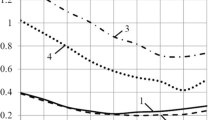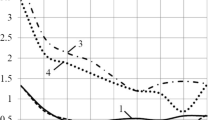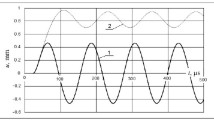The effect of metal layer thickness on the stress-strain state and strength of metal composite cylinders of constant total thickness under the action of internal dynamic pressure from an explosion of an explosive evenly distributed along the charge axis in an air medium with a constant relative charge mass ξ has been studied numerically. It is shown that the strength of shells with unidirectional circular reinforcement of the outer composite layer using composites with a low tensile strength boundary in the isotropy plane is determined mainly by wave processes along the thickness of the shell. For such a condition, its dependence on radial and axial stresses is much higher than on circular stresses, which are usually much larger for the first two components of the stress tensor. At constant ξ and total thicknesses H of the cylinder, the optimal ratio βopt of the thickness of the metal layer h to H in terms of durability essentially depends on H and varies in the interval 0.15–0.35. The dependence βopt on both H and ξ is non-monotone. It varies between 0.15 and 0.25 for a thin shell, 0.25–0.3 for a thick shell, and equal to 0.35 for a medium-thick shell. Due to wave processes along the radial coordinate, there may be cases where a thicker shell will be less strong than a thinner one with the same charge mass M and h/H. There may be cases where a change of M almost 1.5 times will have almost no effect on the strength of the cylinder. Significant influence on the strength of the shells have plastic irreversible energy losses in the inner steel layer, due to which the outer composite layer receives a shock wave of less intensity, and the strength of the object as a whole can be ensured.





Similar content being viewed by others
References
O. S. Vorontsova, M. A. Syrunin, A. G. Fedorenko, et al., “Experimental study of variation coefficients of strength characteristics of fiberglass cylindrical shells under internal pulse loading”, Mekh. Kompoz. Mater., No. 4, 642–646 (1987).
V. I. Tsypkin, V. N. Rusak, A. G. Ivanov, et al., “Deformation and fracture of two-layered metal-plastic shells under internal pulse loading,” Mekh. Kompoz. Mater., No. 5, 833–838 (1987).
A. G. Fedorenko, M. A. Syrunin, and A. G. Ivanov, “Limit deformations of oriented fiberglass shells under internal explosive loading,” Fiz. Goren. Vzryv., No. 2, 87–93 (1992).
A. G. Ivanov, A. G. Fedorenko, and M. A. Syrunin, “Influence of reinforcement structure on the limit deformability and strength of glass fiber reinforced plastic shells under explosive loading from the inside,” Prikl. Mekh. Tekhn. Fiz., No. 4, 130–135 (1992).
A. G. Fedorenko, M. A. Syrunin, and A. G. Ivanov, “Dynamic strength of shells made of oriented fibrous composites under explosive loading (a review)”, Prikl. Mekh. Tekhn. Fiz., No. 1, 126–132 (1993).
M. A. Syrunin, A. G. Fedorenko, and A. G. Ivanov, “Dynamic strength of shells made of oriented composites based on fibers of different compositions,” Prikl. Mekh. Tekhn. Fiz., No. 3, 141–145 (1995).
A. I. Abakumov, P. N. Nizovtsev, V. P. Solov’ev, et al., “Calculated and experimental study of stress and strain state of composite shells under dynamic loading in view of large deformations”, Mekh. Kompoz. Mater., No. 1, 28–37 (1998).
V. A. Ryzhanskii, V. N. Rusak, and A. G. Ivanov, “Evaluation of explosion resistance of cylindrical composite shells,” Fiz. Goren. Vzryv., No. 1, 115–121 (1999).
A. G. Ivanova (Ed.), Fracture of Different-Scale Objects during Explosion [in Russian], RFNC-VNIIEF, Sarov (2001).
V. N. Rusak, A. G. Fedorenko, M. A. Syrunin, et al., “The limit deformability and strength of basalt-plastic shells under internal explosive loading,” Prikl. Mekh. Tekhn. Fiz., No. 1, 186–195 (2002).
N. A. Abrosimov and N. A. Novosel’tseva, “Numerical analysis of progressive fracture of metal-plastic cylindrical shells under pulse loading,” in: Proc. of the XI Int. Conf. on Nonequilibrium Processes in Nozzles and Jets (NPNJ2016), (May 25–31, 2016, Alushta), MAI, Moscow (2016), pp. 289–291.
N. A. Abrosimov and N. A. Novosel’tseva, “The identification of material parameters in nonlinear deformation models of metallic-plastic cylindrical shells under pulsed loading,” Mater. Phys. Mech., 23, 66–70 (2015).
P. P. Lepikhin and V. A. Romaschenko, The Strength of Inhomogeneous Anisotropic Hollow Cylinders under Pulse Loading [in Russian], Naukova Dumka, Kiev (2014).
V. A. Romaschenko, Yu. N. Babich, and E. V. Bakhtina, “Strength assessment for composite and metal-composite cylinders under pulse loading. Part 2. Numerical evaluation of strength for multilayer cylinders of finite length under internal explosion”, Strength Mater., 44, No. 5, 502–511 (2012), https://doi.org/10.1007/s11223-012-9403-4.
P. P. Lepikhin, V. A. Romaschenko, O. S. Beiner, et al., “A program for numerical calculation of dynamic stress-strain state and strength of hollow multilayer anisotropic cylinders and spheres. Part 2. Comparison of numerical results with experimental and theoretical for cylinders”, Strength Mater., 47, No. 3, 406–414 (2015), https://doi.org/10.1007/s11223-015-9671-x.
P. P. Lepikhin, V. A. Romaschenko, and O. S. Beiner, “A numerical study of 3D dynamics and strength of metal-composite cylinders under internal explosion loading”, Strength Mater., 49, No. 6, 796–808 (2017), https://doi.org/10.1007/s11223-018-9925-5.
P. P. Lepikhin, V. A. Romaschenko, and Yu. N. Babich, “Interlayer gap effect on the dynamics and strength of two-layer metal composite cylinders under internal explosion”, Strength Mater., 52, No. 2, 214–227 (2020), https://doi.org/10.1007/s11223-020-00168-9.
P. P. Lepikhin, V. A. Romaschenko, and O. S. Beiner, “Modeling of three-dimensional stress-strain state and strength analysis of metal composite cylinders under impulsive loading using the CONWEP method”, Strength Mater., 52, No. 6, 864–875 (2020), https://doi.org/10.1007/s11223-021-00240-y.
V. V. Adishchev, V. M. Kornev, and L. A. Talzi, Estimation of Maximum Stresses in Closed Cylindrical Vessels during Axisymmetric Explosive Loading [in Russian], Report in Research, No. 6588 83, IGD SB AS USSR, Novosibirsk (1983).
G. Randers-Pehrson and K. A. Bannister, Airblast Loading Model for Dyna-2D & Dyna-3D, ARL-TR-1310, Army Research Laboratory (1997).
D. W. Hyde, User’s Guide for Microcomputer Program CONWEP, Application of TM5-855-1, Fundamentals of Protective Design for Conventional Weapons (1992).
N. N. Malinin, Applied Theory of Plasticity and Creep [in Russian], Mashinostroenie, Moscow (1975).
S. G. Lekhnitskii, Theory of Anisotropic Body Elasticity [in Russian], Nauka, Moscow (1977).
G. S. Pisarenko, A. P. Yakovlev, and V. V. Matveev, Reference on Resistance of Materials [in Russian], Delta, Kiev (2008).
P. P. Lepikhin, V. A. Romaschenko, O. S. Beiner, et al., “A program for numerical calculation of dynamic stress-strain state and strength of hollow multilayer anisotropic cylinders and spheres. Part 1. Program description”, Strength Mater., 47, No. 2, 249–256 (2015), https://doi.org/10.1007/s11223-015-9655-x.
M. L. Wilkins, “Calculation of elastic-plastic flow,” in: Computational Methods in Hydrodynamics [Russian translation], Mir, Moscow (1967), pp. 212–263.
N. K. Naik, Y. Chandra Sekher, and Sailendra Meduri, “Damage in woven-fabric composites subjected to low-velocity impact”, Compos. Sci. Technol., 60, No. 5, 731–744 (2000).
Author information
Authors and Affiliations
Corresponding author
Additional information
Translated from Problemy Mitsnosti, No. 3, pp. 18 – 32, May – June, 2022.
Rights and permissions
Springer Nature or its licensor holds exclusive rights to this article under a publishing agreement with the author(s) or other rightsholder(s); author self-archiving of the accepted manuscript version of this article is solely governed by the terms of such publishing agreement and applicable law.
About this article
Cite this article
Lepikhin, P.P., Romashchenko, V.A., Beiner, O.S. et al. Influence of Metal Layer Thickness on the Stress-Strain State and Strength of Metal Composite Cylinders Under Internal Explosion. Strength Mater 54, 358–371 (2022). https://doi.org/10.1007/s11223-022-00411-5
Received:
Published:
Issue Date:
DOI: https://doi.org/10.1007/s11223-022-00411-5




